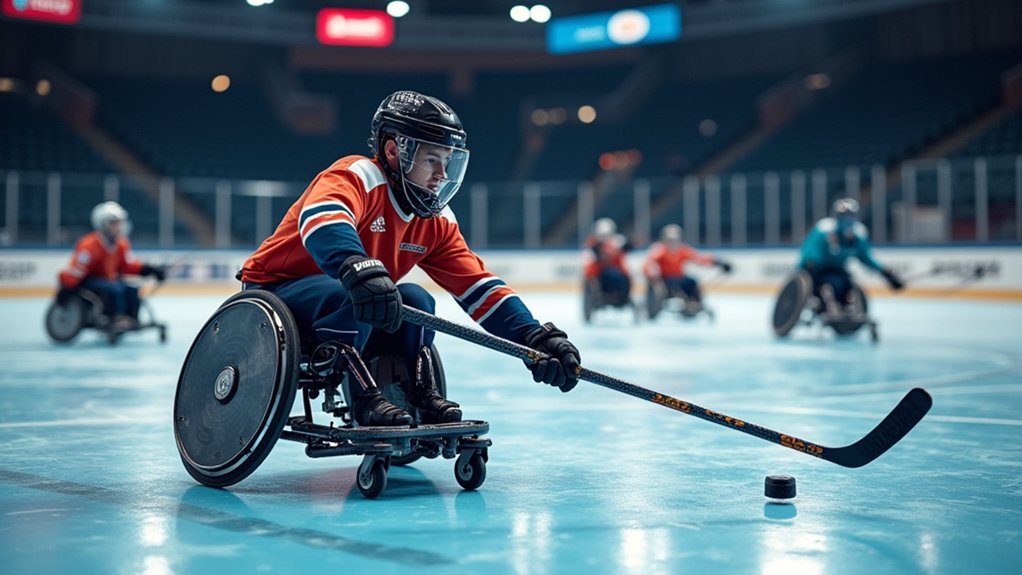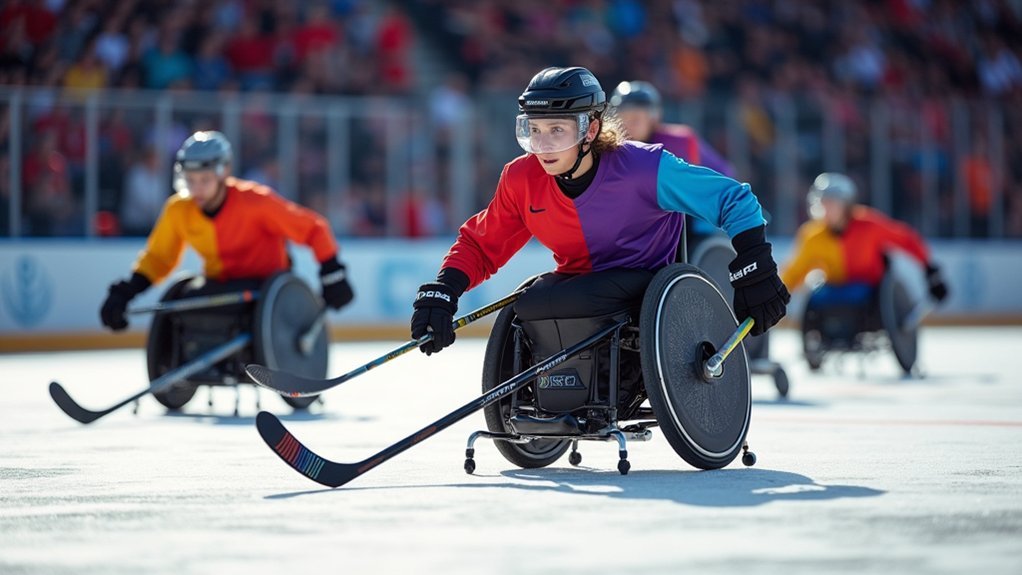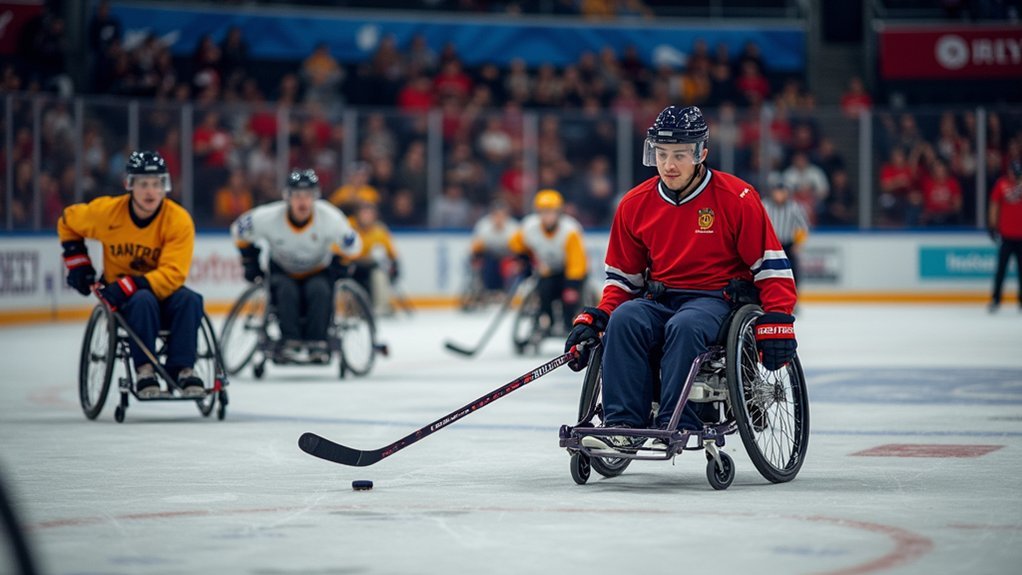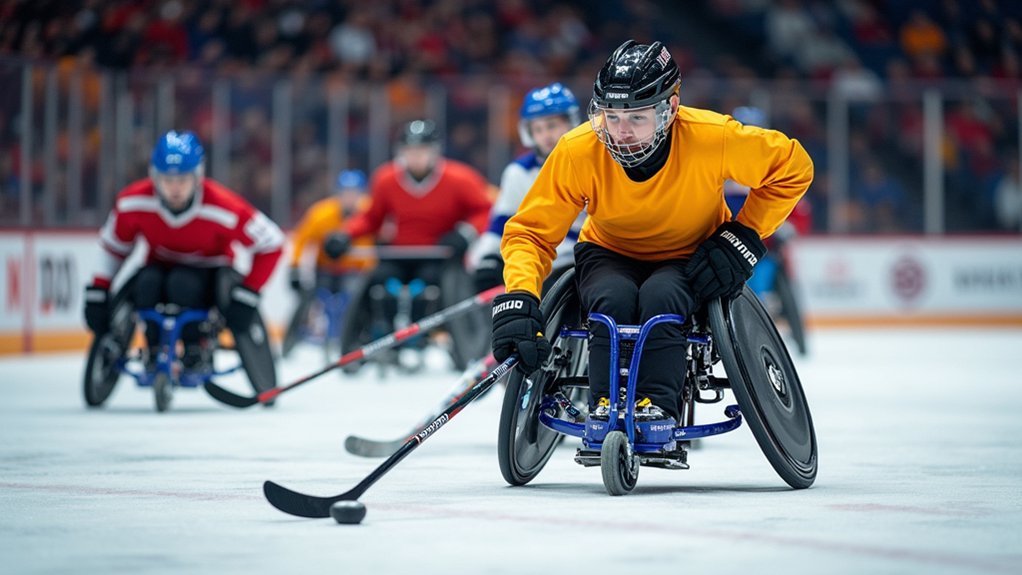Wheelchair hockey sticks transform mobility sports by removing physical barriers through specialized designs. You’ll find features like customizable grips, lightweight carbon fiber construction, and adjustable lengths that compensate for limited grip strength and enhance player movement. These adaptive tools expand freedom on the court, improve precision, and boost confidence that extends beyond gameplay. Innovations like quick-release systems and balanced weight distribution have revolutionized how athletes with mobility challenges experience competitive play. Discover how these equipment advances are building inclusive communities worldwide.
The Evolution of Adaptive Hockey Stick Design

While traditional hockey sticks once prevented many wheelchair users from fully enjoying the sport, adaptive hockey stick design has undergone remarkable transformation over the past decades.
You’ll now find specialized attachments that compensate for limited grip strength, enabling participation regardless of upper body strength limitations.
Today’s adaptive hockey sticks feature lightweight carbon fiber construction that reduces fatigue during extended play. The customizable grips and adjustable lengths guarantee you get a perfect fit for your specific mobility needs.
Innovations in stick design include curved blades that dramatically improve your shooting accuracy and puck control.
Most exciting is the integration of smart technology in newer models—electronic sensors provide real-time feedback on your performance, helping you refine techniques and develop more effective game strategies without guesswork.
Specialized Features That Enhance Player Mobility
Specialized features like extended reach designs let you access the puck from various positions without compromising your wheelchair’s stability.
Quick-release clamping systems enable you to adjust your stick’s length mid-game, adapting to different play situations as they arise.
Balanced weight distribution across the stick reduces fatigue in your arms and shoulders, allowing you to maintain control and precision throughout extended periods of play.
Extended Reach Designs
Unlike standard hockey equipment, wheelchair hockey sticks feature innovative extended reach designs that greatly enhance player mobility on the court.
You’ll find these sticks are purposefully shorter and lighter, reducing fatigue while improving your handling capabilities during intense gameplay.
The specialized paddle end allows you to maintain precise control of the puck from your seated position, making accurate passes and powerful shots possible despite mobility limitations.
Many designs include adjustable lengths, so you can customize your reach based on your specific needs and playing style.
Special grip features benefit players with limited upper body strength, ensuring you can maintain control throughout the match.
These thoughtful design elements aren’t just equipment modifications—they’re transformative tools that expand participation and competitive potential in wheelchair hockey.
Quick-Release Clamping Systems
Three revolutionary quick-release clamping systems have transformed wheelchair hockey, giving you unprecedented control over your equipment during fast-paced gameplay.
These innovative mechanisms allow wheelchair users to attach and detach sticks instantaneously, dramatically enhancing on-court mobility.
You’ll appreciate how these systems secure your stick at customizable angles and heights, adapting to your specific playing style and physical capabilities.
The clamps maintain rock-solid stability during puck handling while enabling swift shifts when you need to focus on wheelchair movement.
For athletes with disabilities, these quick-release clamping systems eliminate frustrating equipment delays, keeping you in the action.
They’ve democratized the sport by accommodating players with varying upper-body strength and dexterity, ensuring everyone can participate effectively regardless of mobility limitations.
Balanced Weight Distribution
Balanced weight distribution represents a fundamental advancement in wheelchair hockey stick design, complementing the quick-release systems with enhanced maneuverability during play.
You’ll notice immediate improvements in your ability to make quick directional changes while maintaining control over the puck.
Unlike their counterparts in wheelchair basketball, hockey sticks feature lightweight materials strategically positioned to optimize mobility without sacrificing performance.
The ergonomic grips support your hand positioning, allowing for efficient propulsion during intense gameplay.
Shorter stick lengths provide better leverage, enabling you to execute precise movements while maintaining stability.
Many players benefit from adjustable features that cater to individual preferences, ensuring your mobility isn’t compromised during competition.
This thoughtful engineering means you’ll spend less energy managing your equipment and more time focusing on your game strategy.
Impact on Physical Independence and Athletic Performance
Wheelchair hockey sticks don’t just enable you to play—they dramatically expand your freedom of movement on the court, transforming physical limitations into opportunities for athletic expression.
You’ll find your performance ceiling vanishes as these adaptive tools convert your existing abilities into powerful competitive advantages.
Your independence grows with each practice session as you master stick techniques that complement your unique mobility, allowing you to compete based on skill rather than physical capability.
Movement Freedom Amplified
As athletes glide across the court with unprecedented control, specialized hockey sticks transform the wheelchair sporting experience by amplifying movement freedom in ways traditional equipment cannot.
You’ll notice the lightweight, ergonomic wheelchair hockey sticks enable remarkable maneuverability while strengthening your upper-body muscles with each play.
The freedom these adaptive tools provide can’t be overstated:
- Enhanced puck handling capabilities let you execute precise movements that weren’t possible before
- Customizable attachments accommodate various mobility limitations, making the sport truly inclusive
- Improved stick control translates to increased independence both on and off the court
With each swift movement, you’re not just playing hockey—you’re developing coordination and confidence that extends beyond the game, empowering you to navigate life’s challenges with greater physical autonomy.
Performance Ceiling Eliminated
Traditional notions of athletic capability shatter when innovative wheelchair hockey stick designs enter the game, effectively eliminating the performance ceiling that once constrained players with mobility challenges.
You’ll find these specialized sticks transform your gameplay by compensating for reduced upper body strength, letting you compete with newfound effectiveness. The adaptive attachments improve your handling and maneuverability without taxing your physical resources, so you’ll experience less strain during intense matches.
With enhanced stick technology, you’re able to propel yourself with greater precision while maintaining superior puck control.
Athletes with disabilities now achieve unprecedented performance levels as their speed and accuracy dramatically improve. The technological advancements don’t just make wheelchair hockey more accessible—they enable you to push beyond previous limitations and redefine what’s possible in adaptive sports competition.
How Different Hockey Variants Utilize Adaptive Sticks

Hockey’s adaptive variants showcase remarkable innovation in stick design, tailored to the specific needs of players with different mobility considerations.
In sled hockey, you’ll use dual-purpose sticks with pick ends for propulsion and blade ends for puck control, enabling effective play while seated on sledges.
Wheelchair hockey replaces conventional equipment with plastic or composite adaptive sticks, creating opportunities for players with reduced upper body strength.
Adaptive sticks revolutionize wheelchair hockey, empowering athletes with limited upper body strength to fully engage in competitive play.
- Volt hockey features motorized wheelchairs with built-in paddle attachments that function as sticks, eliminating barriers for those with significant mobility challenges.
- Sled hockey utilizes shorter dual-ended sticks that serve both movement and gameplay functions.
- Wheelchair hockey incorporates customizable stick attachments that can be adjusted based on individual abilities and needs.
These specialized designs fundamentally transform mobility sports, making competitive play accessible to athletes of all abilities.
Accessibility Barriers Overcome Through Equipment Innovation
While physical limitations once sidelined potential athletes, today’s innovative wheelchair hockey equipment has transformed the landscape of adaptive sports.
You’ll find that specialized sticks with customizable attachments now enable players with limited upper body strength to maneuver effectively, breaking down fundamental mobility barriers.
The integration of lightweight materials and personalized grips means you can compete regardless of your physical challenges.
These advancements create a level playing field where your abilities—not disabilities—define your performance.
Joystick controls and adaptive technologies in sport chairs further enhance your capacity to engage fully in wheelchair hockey without conventional equipment restrictions.
These innovations don’t just improve gameplay; they promote inclusion by addressing specific mobility limitations, allowing you to experience the thrill of competitive sports that was once inaccessible.
Building Community Through Inclusive Equipment Design

Beyond merely enabling play, inclusive wheelchair hockey stick designs create vibrant communities where athletes of all abilities thrive together.
You’ll find these adaptive sports tools breaking down social barriers while fostering teamwork among players with disabilities.
Organizations like INCIGHT partner with local charities to distribute specialized equipment, ensuring everyone can participate regardless of physical limitations.
Community programs like volt hockey showcase how inclusive equipment design transforms lives through:
- Enhanced social connections between participants who might otherwise remain isolated
- Improved physical fitness through accessible competitive play
- Strengthened emotional well-being from the shared experience of team sports
When you provide adaptive hockey sticks with customized attachments for limited grip strength, you’re not just offering equipment—you’re building a supportive community where everyone belongs.
Frequently Asked Questions
How Does Disabled Hockey Work?
You’ll play seated in a sled or wheelchair, using adapted sticks. Sled hockey features ice-mounted sledges with dual sticks for control, while wheelchair hockey uses plastic balls. Both welcome various disability levels without classification requirements.
What’s the Difference Between a Street Hockey Stick and an Ice Hockey Stick?
Your street hockey stick is lighter with a wider, flatter blade for ball control, while your ice hockey stick is heavier with a curved blade designed specifically for puck handling and ice play.
Can Able-Bodied People Play Sled Hockey?
Yes, you can play sled hockey as an able-bodied person. You’ll sit in a sled and use your upper body strength, making it inclusive for people with lower body disabilities or injuries.
What Is Adaptive Hockey?
Adaptive hockey is a collection of modified sports you’ll find that includes sled hockey and volt hockey. It’s designed specifically for people with disabilities, allowing you to participate in hockey regardless of mobility challenges.
In Summary
Wheelchair hockey sticks aren’t just equipment—they’re freedom. You’ll find your mobility transformed when using these adaptive tools designed specifically for your needs. They’ve broken barriers, enhanced your performance, and connected you to a vibrant community. As technology and awareness continue to evolve, you’re part of a growing movement where inclusive design guarantees everyone can experience the thrill of competitive sports.





Leave a Reply